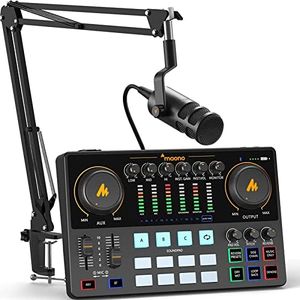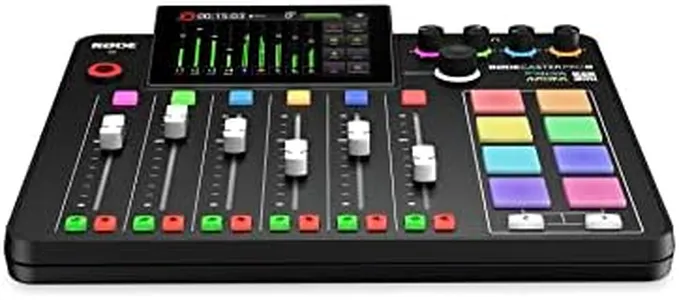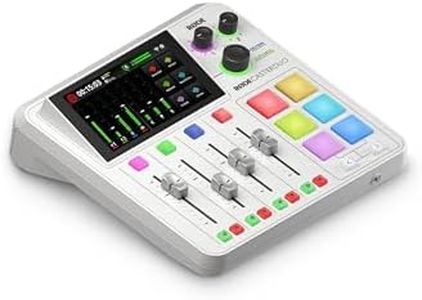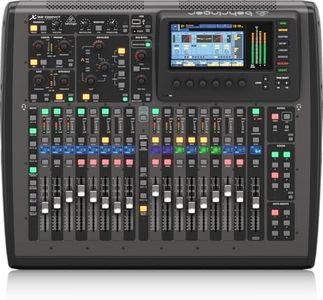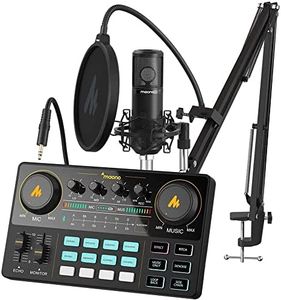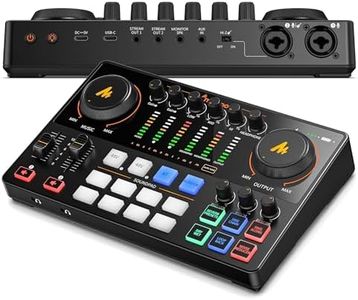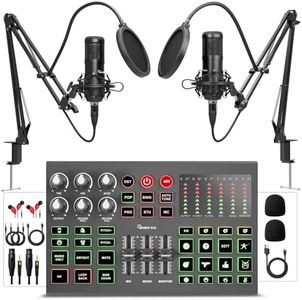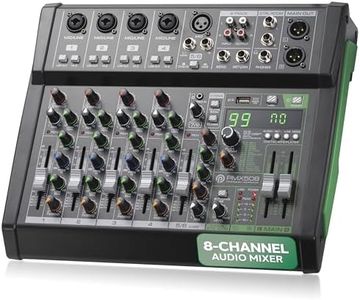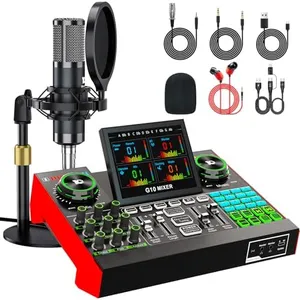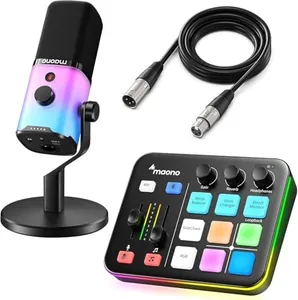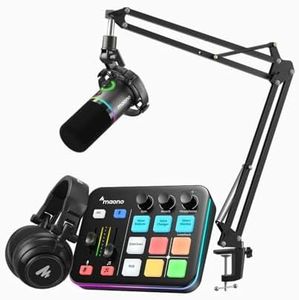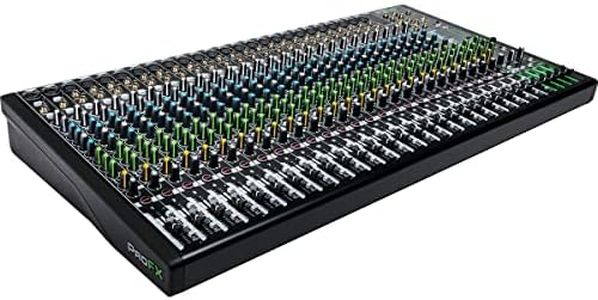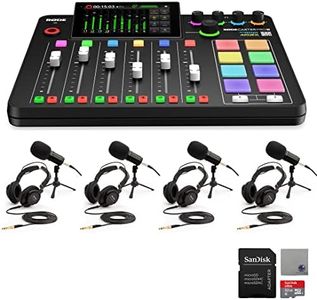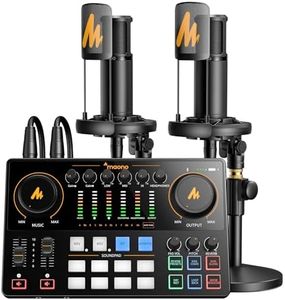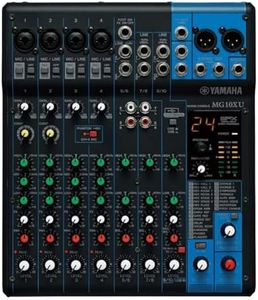10 Best Podcast Mixers 2025 in the United States
Our technology thoroughly searches through the online shopping world, reviewing hundreds of sites. We then process and analyze this information, updating in real-time to bring you the latest top-rated products. This way, you always get the best and most current options available.

Our Top Picks
Winner
RØDE RØDECaster Pro II All-in-One Production Solution for Podcasting, Streaming, Music Production and Content Creation,Black
Most important from
3416 reviews
The RØDE RØDECaster Pro II is a solid choice for those diving into podcasting, streaming, and music production. One of its standout features is the nine channels, which include six physical faders and three virtual ones. This allows for versatile mixing options, making it easier to manage multiple audio sources. The built-in effects are a nice bonus, providing real-time audio enhancements that can elevate your production quality without needing extra software.
Portability is another appealing factor, as its compact design makes it easy to transport, which is great for creators on the go. The USB Type-C connectivity ensures a hassle-free setup with modern devices, and it's compatible with both macOS and Windows, catering to a broad range of users.
The RØDECaster Pro II also boasts ultra-low-noise, high-gain preamps, which promise clear audio even at high volumes. This is essential for professionals wanting high-quality recordings. The support for phantom power means you can use professional-grade microphones without any issues. There are a few considerations to keep in mind. While the ease of use is generally praised, those who are completely new to audio mixing might find the array of features a bit overwhelming at first. Additionally, some users report that the weight of the unit, about 4.4 pounds, can be a bit hefty for travel, especially if you’re carrying several other pieces of equipment.
The RØDE RØDECaster Pro II excels in delivering a high-quality, integrated production experience for podcasters and content creators. It may require a slight learning curve for complete beginners, but its robust features make it a worthy investment for those serious about their audio quality.
Most important from
3416 reviews
RØDE RØDECaster Duo Compact All-in-One Audio Production Solution for Podcasting, Streaming, Music Production and Content Creation (White)
Most important from
3416 reviews
The RØDE RØDECaster Duo is a compact and well-designed audio mixer tailored for podcasting, streaming, and content creation. It offers four channels with two high-quality combo inputs that support microphones and instruments, making it versatile for different audio sources. The mixer delivers excellent audio clarity thanks to ultra-low-noise preamps and includes studio-grade built-in effects like the Aural Exciter and Big Bottom, which can enhance your recordings without needing extra gear.
Connectivity is a strong point here, with dual USB-C ports, Bluetooth, Wi-Fi, Ethernet, and support for RØDE’s wireless microphones, providing many options to connect devices easily. Phantom power is available for condenser microphones, which is essential for professional-quality audio. The 4 broadcast-quality faders, a high-resolution touchscreen with haptic feedback, and six programmable smart pads add to the device’s user-friendly nature, making it practical to control your mix during sessions. Portability is decent—it's not pocket-sized but still light enough to carry for remote recordings.
One consideration is that while the four channels are sufficient for many podcasters, those needing more inputs might find it limiting. Also, the price point and feature set cater to users willing to invest in a reliable all-in-one solution rather than an entry-level device. This mixer suits podcasters and creators looking for a powerful, easy-to-use device with modern connectivity and built-in effects, especially if you value wireless mic support and a touchscreen interface.
Most important from
3416 reviews
BEHRINGER X32 COMPACT
The Behringer X32 Compact is a powerful digital mixer with 40 input channels and 16 programmable mic preamps, making it well-suited for podcasters who need to manage multiple microphones or audio sources simultaneously. It offers a built-in virtual effects rack, allowing you to add professional-sounding audio effects without extra gear. USB connectivity is included, enabling easy recording or streaming directly to a computer, a key feature for podcasting setups. Phantom power is available on mic inputs, so you can use condenser microphones that require extra power.
On the downside, the unit is quite heavy (over 45 pounds) and large, which limits portability if you plan to move it frequently or set up in different locations. The mixer features 17 motorized faders and a 7-inch color screen, which help with control and visibility, but might have a learning curve for beginners. Its size and complexity might be more than what casual or solo podcasters need, but for those with multiple hosts or guests, or integrating various audio sources, it offers flexibility and professional-quality sound control.
This makes it a strong choice for podcasters who want a versatile and feature-rich mixer and are comfortable managing a bulkier design.
Buying Guide for the Best Podcast Mixers
Choosing the right podcast mixer can significantly enhance the quality of your recordings and make the production process smoother. A podcast mixer allows you to control and adjust audio levels, add effects, and manage multiple audio sources. When selecting a podcast mixer, it's important to consider your specific needs, such as the number of participants, the type of content you produce, and your level of technical expertise. Here are some key specifications to consider when choosing a podcast mixer and how to navigate them to find the best fit for you.FAQ
Most Popular Categories Right Now
